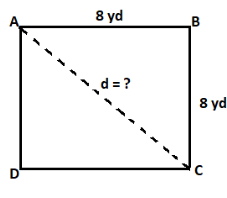
What is the length of a square diagonal in the figure below ?

\[
A.{\text{ }}2\sqrt 8 yd \\
B.{\text{ }}8\sqrt 2 yd \\
C.{\text{ }}2\sqrt 5 yd \\
D.{\text{ }}5\sqrt 2 yd \\
\]

Answer
599.7k+ views
Hint: All the sides of the square are equal and according to the property of the square all the angles of a square are equal to \[{90^0}\]. So, the diagonal of the square divides it into two right angle triangles. Use this property to apply Pythagoras in any of the two triangles and get the length of diagonal.
Complete step-by-step answer:
Now as we know that the diagonals of a square divide it into two right angle triangles with the diagonal as its hypotenuse. And other two sides as base and perpendicular.
So, triangle ABC in the above square should be a right-angle triangle.
In which AC is the hypotenuse because angle B is equal to \[{90^0}\](all angles of the square are equal to \[{90^0}\]).
And, AB and BC are base and perpendicular of the triangle ABC
So, now as we know if we are given with the two sides of the right-angled triangle then we can find the length of the third side by using Pythagoras theorem which states that \[{\left( {{\text{Hypotenuse}}} \right)^2} = {\left( {{\text{Perpendicular}}} \right)^2} + {\left( {{\text{Base}}} \right)^2}\]
So, now applying Pythagoras Theorem in triangle ABC. We get,
So, now putting the value of base and perpendicular in Pythagorean theorem. We get,
\[{\left( {{\text{AC}}} \right)^2} = {\left( {{\text{AB}}} \right)^2} + {\left( {{\text{BC}}} \right)^2}\]
\[{\left( {{\text{AC}}} \right)^2} = {\left( {\text{8}} \right)^2} + {\left( 8 \right)^2} = 64 + 64 = 128\]
Now taking the square root to both sides of the above equation. We get,
\[{\text{AC}} = \sqrt {128} = 8\sqrt 2 \]
So, the length of the diagonal AC of the given square is \[8\sqrt 2 \]yards.
Hence, the correct option will be B.
Note: Whenever we come up with this type of problem then if the triangle formed is right angled triangle and we are given two of the three sides of the triangle then to find the third side of the triangle we must apply Pythagoras theorem which states that if in a triangle XYZ if Z is the right angle of the triangle then \[{\left( {{\text{XY}}} \right)^2} = {\left( {{\text{YZ}}} \right)^2} + {\left( {{\text{ZX}}} \right)^2}\]. After putting the length of two sides in this theorem we will get the length of the third side.
Complete step-by-step answer:
Now as we know that the diagonals of a square divide it into two right angle triangles with the diagonal as its hypotenuse. And other two sides as base and perpendicular.
So, triangle ABC in the above square should be a right-angle triangle.
In which AC is the hypotenuse because angle B is equal to \[{90^0}\](all angles of the square are equal to \[{90^0}\]).
And, AB and BC are base and perpendicular of the triangle ABC
So, now as we know if we are given with the two sides of the right-angled triangle then we can find the length of the third side by using Pythagoras theorem which states that \[{\left( {{\text{Hypotenuse}}} \right)^2} = {\left( {{\text{Perpendicular}}} \right)^2} + {\left( {{\text{Base}}} \right)^2}\]
So, now applying Pythagoras Theorem in triangle ABC. We get,
So, now putting the value of base and perpendicular in Pythagorean theorem. We get,
\[{\left( {{\text{AC}}} \right)^2} = {\left( {{\text{AB}}} \right)^2} + {\left( {{\text{BC}}} \right)^2}\]
\[{\left( {{\text{AC}}} \right)^2} = {\left( {\text{8}} \right)^2} + {\left( 8 \right)^2} = 64 + 64 = 128\]
Now taking the square root to both sides of the above equation. We get,
\[{\text{AC}} = \sqrt {128} = 8\sqrt 2 \]
So, the length of the diagonal AC of the given square is \[8\sqrt 2 \]yards.
Hence, the correct option will be B.
Note: Whenever we come up with this type of problem then if the triangle formed is right angled triangle and we are given two of the three sides of the triangle then to find the third side of the triangle we must apply Pythagoras theorem which states that if in a triangle XYZ if Z is the right angle of the triangle then \[{\left( {{\text{XY}}} \right)^2} = {\left( {{\text{YZ}}} \right)^2} + {\left( {{\text{ZX}}} \right)^2}\]. After putting the length of two sides in this theorem we will get the length of the third side.
Recently Updated Pages
Master Class 8 Social Science: Engaging Questions & Answers for Success

Master Class 8 Maths: Engaging Questions & Answers for Success

Master Class 8 Science: Engaging Questions & Answers for Success

Class 8 Question and Answer - Your Ultimate Solutions Guide

Master Class 8 English: Engaging Questions & Answers for Success

Master Class 6 English: Engaging Questions & Answers for Success

Trending doubts
What is BLO What is the full form of BLO class 8 social science CBSE

Which one of the following groups comprises states class 8 social science CBSE

Citizens of India can vote at the age of A 18 years class 8 social science CBSE

Full form of STD, ISD and PCO

A couple went for a picnic They have 5 sons and each class 8 maths CBSE

Right to vote is a AFundamental Right BFundamental class 8 social science CBSE





